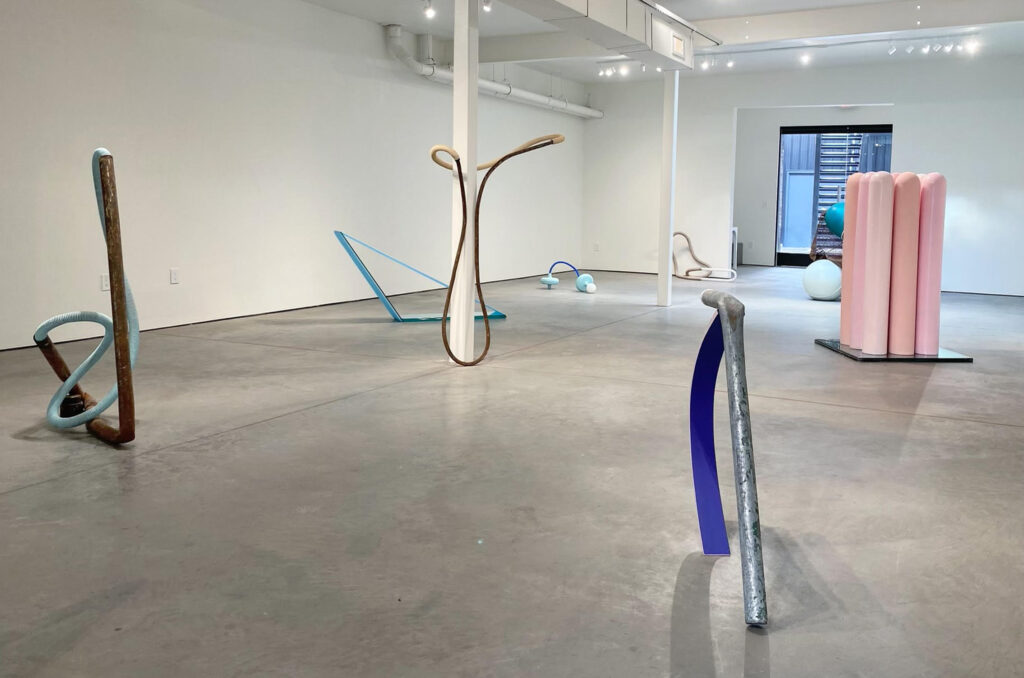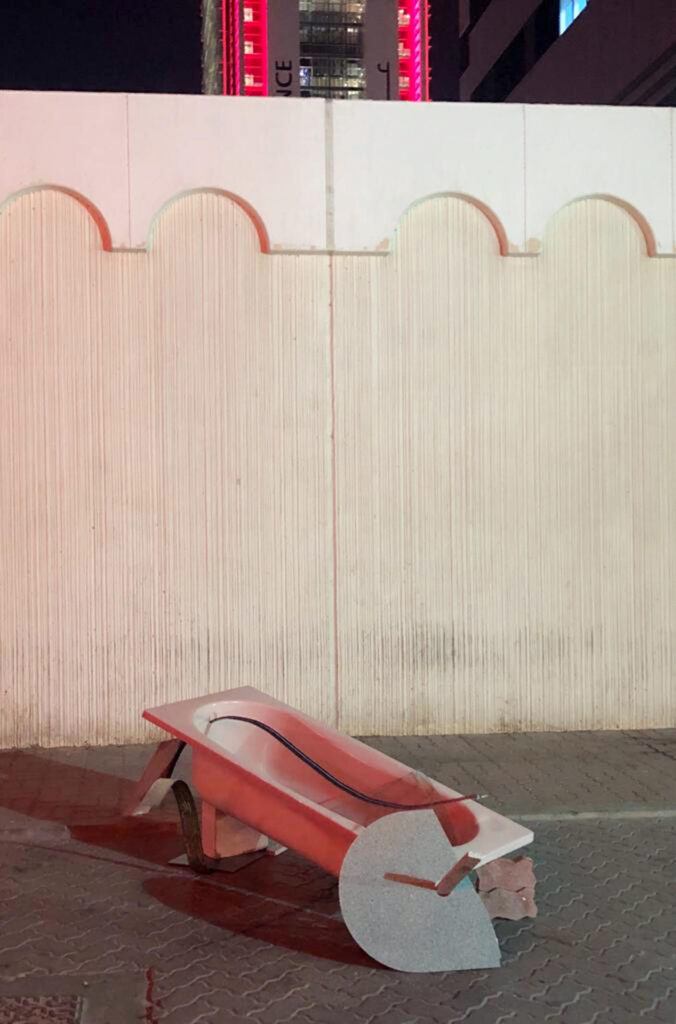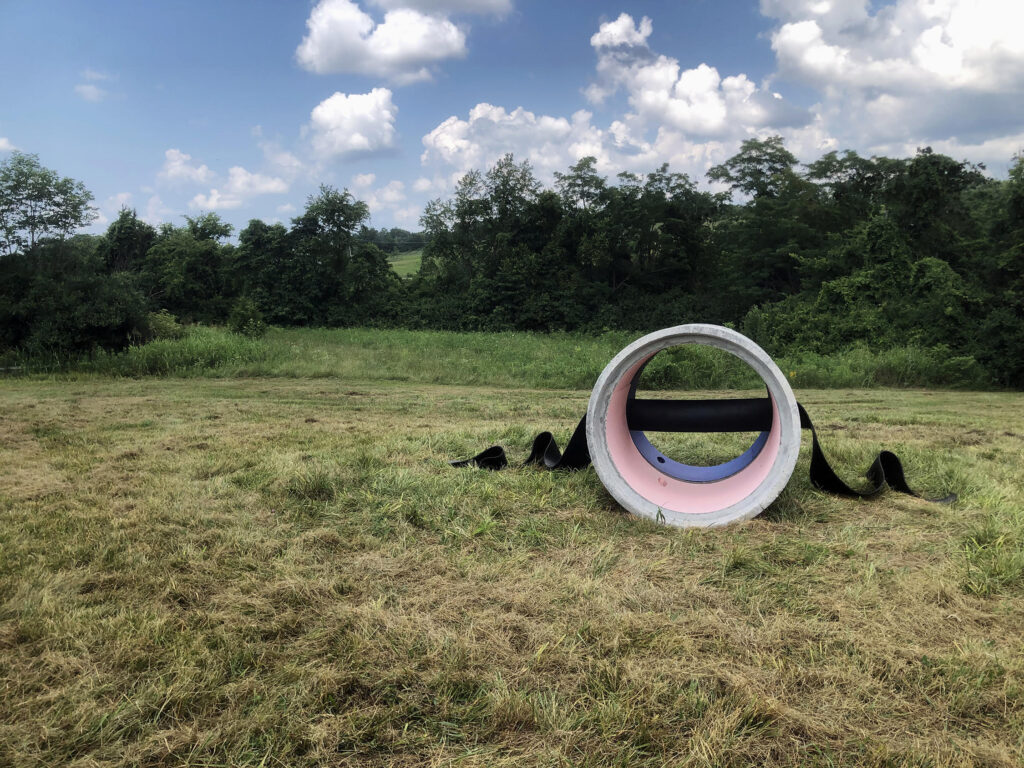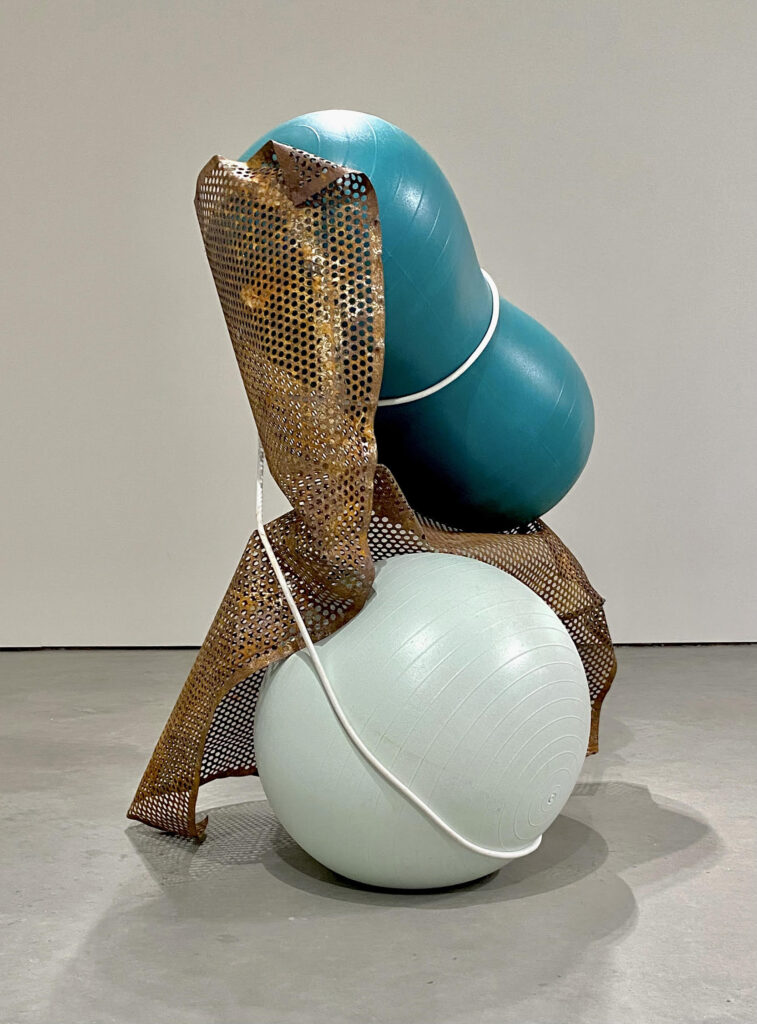In a large and open studio space on the edge of Louisville’s Portland neighborhood, an array of disparate objects are sprawled out on the floor. Walking through her studio, interdisciplinary artist Kiah Celeste points to sandbags covered in neoprene and faux-leather jackets, slumping and resting on the floor and each other, noting how the objects and composition are both “heavy and weird.†A writhing, hundred-foot length of recovered fiberglass ducting is piled nearby. A gymnastics balance beam covered in upholstery material and painted vibrant blue occupies another section of floor space. Shelving and work surfaces hold containers and collections of the raw materials that will combine to become performative, sculptural assemblages, guided by Celeste’s artistic intervention into the former lives of these recovered, post-industrial elements.
As she surveys a box of golf balls and motions toward a hard-worn football striking-pad, the artist defines her materials as, “Really just a bunch of garbage that’s fun…a bunch of stuff that I’m like ‘Ooo, I want to play with that!’.â€
Indeed, her recent works are playful combinations of reclaimed elements that rely on balance and gestalt to assert a new material narrative, one that defines aesthetic as function. The striking results of her explorations in the studio, and Celeste’s overall evolution into the artist she is now, have come from personal expansion and creative versatility.
________
Celeste was born and raised in Brooklyn, New York. She moved around between the neighborhoods of Flatbush, Midwood, Sunset Park, Bensonhurst, and Borough Park before heading to SUNY Purchase in Westchester County, New York, for her undergraduate studies in fine art photography. After finishing her degree at Purchase, Celeste felt a need for more. She explains she wasn’t looking for an escape; she was yearning for expansion:
People are like “You’re from New York, why would you ever want to leave, that’s where everyone wants to go,†but it’s still like to me, growing up there, that’s not what it was, it was just my home. In retrospect it’s like, “Yeah, it’s like the best place in the world,†but when I was living there it was just a place to me, and it was just my life, and I wanted to find out what else was out there and explore and you know, open up my world, which was just Brooklyn really. My dad went his whole life and never left Brooklyn, and that sounds like a nightmare to me. Some people like that, but I like to move around… So by the time I graduated school, I was just like, “I’m getting out of here. I’m just going somewhere,†just because I’d never been anywhere before. As I started traveling more and more it made me really appreciate where I come from.
Where we come from is more than a neighborhood, or a city, or a state. Families, communities, and institutions all play a role in shaping individuals into artists. As a child, Celeste loved drawing and dancing, and her parents nurtured those creative expressions:
My dad taught me how to sew, so I’ve been sewing since I was like little little. My dad, he played guitar and he drew, and he wrote poetry, and my mom went to the Manhattan School of Music… Both my parents were very creative people, artistic people, and that just seemed natural in my house. But I didn’t make a decision when I was little to be like “I’m gonna be an artist when I grow up!†That kind of came later.
In elementary school, Celeste began formal training in dance, continuing that training through high school. But ultimately, the necessity to work within a company, and the interpersonal requirements of dance, pushed her toward alternative expressions, citing a need for personal space and time to foster creative growth. In photography, Celeste found that space, and chose to pursue lens-based work as her focus in college. Her undergraduate work was grounded in street photography, channeling a likeness to the works of Gary Winogrand, collecting candid images of people in public. However, the desire to expand her creative lexicon and balance her energies pushed Celeste to adapt her output again:
By the time I was finishing up my senior year in college, I felt like I was really restricting myself as a photographer in this two-dimensional world, and I decided to do a performance for my thesis project and document it through photo, and also have a physical archive and a video compilation, and an installation. And it was me, like, exploding with all of this repressed creativity, or like I needed to release a different side of myself that I was submitting to, being a two-dimensional artist for four years.

Free from the restraints and dogma of academia, Celeste forged a path to working with objects over images. She began by fastening objects to walls with hardware and calling them three-dimensional paintings. She states that it was a natural progression from those early three-dimensional experiments to her current work:
I decided to completely reject any type of hardware and any necessity for proper installation, which cut out a middle part of the process, which was great because I really don’t have any patience. So it made everything go faster, and allowed me to be more immediate with my pieces, and also I didn’t have to spend money on hardware. And I thought it added an element to the work itself, because then the work was entirely a piece of art instead of having elements that are logical, using the logic of having to install something in the piece itself. So instead of using a bracket to help something stand, I use one of my weird objects to help it stand.
The evolution of Celeste as an artist, from dancer to photographer to interdisciplinary creator, is a progression built on intuition and balance. Since childhood, her creative output has been concerned with working in public space, with movement, and bodies, and ideas of performativity and representation. It makes sense that as she has grown as an individual, her practice has grown to maintain the underlying currents of what drives and defines the work, while expanding and adapting what the processes and output actually are.
________
In her studio, Celeste discusses her influences, her processes, and her goals as an artist. Materially and aesthetically, she points to artists such as Richard Serra, Robert Morris, Eva Hesse, and other minimalists as inspiration, though she doesn’t consider herself a minimalist. She relates that she was inspired to read Kant because of Adrian Piper’s connection to the philosopher’s Critique of Pure Reason (1781). Similarly, Celeste purchased a vinyl copy of Boléro, a one-movement orchestral piece arranged by the French composer Maurice Ravel in 1928, because Jean-Michel Basquiat listened to the piece on repeat during a residency in 1982.
She flips through a stack of records showcasing jazz, classical, and Italian film soundtracks, and relates that she’s also a fan of grunge-rock and singer-songwriter albums before summing up her connection to audio-based inspiration:
Music is huge for me. I cannot work without music. Physically, I don’t think I could do it. When I’m installing my shows at other places, at galleries or whatever, I’ll like freeze up because they don’t always play music there and I’m just like, “This show may not go on because I need my music,†[laughter]. I would cease to be an artist without music. I’ve got my little record player here… I’ll be like, in the zone, and the record will be playing, and once it finishes it will just go right back, the needle will go right back to the start, and I’ll just leave it there, for hours, and I realized that that’s what happened to Basquiat.
Celeste has worked on refining her process and practice over the last several years, building a material language and working methodology through necessity and desire. Since 2017 she has completed international projects in Berlin, Germany; Barcelona, Spain; and Abu Dhabi, United Arab Emirates. Local projects include work in Cincinnati, Ohio; Frankfort, Georgetown, and Louisville, Kentucky. Celeste’s inspirations and materials are intimately connected to the locales she visits, where forms and media are literally lifted from the streets:

I think it’s a really nice thing to feel the essence of a place based on the materials that I find. Like in Abu Dhabi the pieces I was finding were very obviously from there, because I was using tiles from the street that you know came out of the ground of UAE, so there’s no mistaking that it’s from there and literally a part of that city. But then there’s other things like that tub [referencing the central figure of the site-specific sculpture Balance Bath, 2019]… I could probably find that tub of the piece I made in UAE anywhere else, I see tubs all the time… I have friends sending me pictures of tubs they find. I had a friend send me a picture of a tub in Iceland and he was like, “This is your Iceland tub!†They all look slightly different but there’s a connection I think…and there’s other little signifiers.
Individually, these signifiers – small markings, logos, and so forth – point to local sources and connections. Collectively though, Celeste’s oeuvre can be viewed as dislocated from a specific time and place, gesturing toward a global aesthetic language built out of regional material dialects.
However, there are limitations in working with this process. Currently, Celeste is unable to show works from different projects in the same show, due to the resources required to ship her pieces internationally. “I don’t have the means to do that yet. But when I made the piece in Abu Dhabi, I was like, ‘This is a piece from Abu Dhabi and for Abu Dhabi, because it’s not coming back with me’.â€
That work had an overtly performative element to it, linked to the temporal aspect of the sculpture going up and coming down, marking Balance Bath as both site- and time-specific. Celeste notes:
That piece was gone a few weeks after I left. I guess the city took it away because it became, like, trash, which is what it was in the beginning, you know?… Now I’m just holding onto my work a little bit, but that’s not to say that I am attached to my work. I mean I’m attached spiritually to my work, but I told myself a long time ago to not become attached to it and to learn to just let go, because it’s just material objects.

At the core, Celeste’s work in her ongoing series I Find This Stable is about exposing the beauty in the unexpected and exploring material relationships. She is seeking to transform the utility of individual objects, highlighting a new functionality as an aesthetic object. Her works are combinations, where multiple materials unite under contrived conditions, alluding to unseen potentials. The artist acts as a sort of guide, coaxing her materials into situational forms and relationships. “I’m using my autonomy with my hands and my brain to bring these inanimate objects together in a way that they would have done if maybe they were able to move on their own,†Celeste posits. Instead of bending metal scraps or splitting wooden shards into aestheticized shapes, she builds works by finding the “natural†ways these reclaimed materials fit together, like a post-industrial jigsaw puzzle.
By bringing these individual materials together to create a cohesive, new whole, Celeste’s process functions as a speculative practice with practical applications. Celeste explains:
It goes back to the balance thing. They’re literally balanced, but they’re also in balance in that there’s not too much of one type of material and not too much of another type of material but they come in contrast with each other to build something that seems likely inevitable to come together. Even though they’re all very disparate, it seems like they were destined for each other in their differences. I’ve been using a minimal amount of objects…three different materials per piece seems like a good amount before it gets too crowded or it gets convoluted. I want to put my hand in there, but I still want it to be its own individual thing, doing whatever it was kind of meant to do, or not meant to do [laughter].

She continues:
I think the facts about these materials – that I’m not buying them, I’m not spending a ton of money to buy these new pieces of plastic and fiberglass and mass produced materials – I think if you know that they’re being repurposed in this way it kind of would automatically make you realize that it is negating the capitalist sensibilities of those materials… so using them in this way is giving them a new life, a beautiful life, a nice kind of dainty life. They get to be art now. They don’t have to be used in this rough, abusive way.
Celeste concedes that the “treasure hunting†aspect of reclaiming and repurposing materials is fun and fulfilling when she’s able to find things, but not so fun when she can’t, which tends to happen a lot. So, seeking out and storing the building blocks of her work is a balancing act in and of itself:
The best is when I’m just driving or walking and I see something and I’m like, “Oh my god what is that!†It just falls in your hands. But that rarely happens here, so I still set out and look for stuff. Sometimes an idea pops in my head and I just need to find this thing, and that’s so hard to do… I really don’t want to be a hoarder, that terrifies me. I want to do things with intention and purpose, so ideally I’ll look for something specific and bring it back to the studio, but I work in a few different ways. If I have an idea for a specific piece, then I go out to look for materials for that piece. Another way is just going out and finding objects I can make into a piece. Sometimes I’ll just have stuff here for months that I know I’ll use but I don’t know how to use it yet and then all the sudden the day comes and it works.
Celeste acknowledges that playfulness, experimentation, and a tinge of humor inflect much of the work:
Exploring and playing is a huge part of getting to the final product. That’s where it all came from, just exploring and finding out how these materials work together and then getting to this final product which was interdependency and balance because of not using hardware or not using practical or logical means, but using the playfulness to get there… I think the irony of the pieces is that they’re kind of these silly objects. You take them seriously, but it’s not like you’re taking them seriously as these industrial objects anymore. They’ve transcended that, they’re beyond that now. For me, it’s hard to look at those vacuum tubes and see them as vacuum tubes, I don’t see them as that anymore. They’re just a thing, they’ve become something else. So if I’m doing it right, then [other] people will be thinking that too.
There is also an aspect of adaptability that Celeste cultivates within her work:
I think that’s a big thing for me, just moving forward and using what you have to get the best result. So in the work, I’m using my resources, [of] which I don’t have many. I don’t have a ton of money to spend on materials, and so it’s gone from a thing of necessity to enjoyability. I’ve adapted to my lack of resources to find resources in my means, and that’s led me to this kind of amazing experience where I’ve had to go out of my comfort zone to find things. That also goes into my priorities environmentally, just being sustainable and repurposing things that are gonna get thrown out and trying to do my part in that sense.
Going from a place of necessity to a place of enjoyment is a beautiful illustration of adaptability. This is an artist embracing her place in the universe as both an individual and as a piece of a larger environment, acknowledging coexistence and harmony while recognizing forces of tension.
________
The pieces in I Find This Stable and much of Celeste’s current output rely on balance and interdependence, conditions the artist advocates in daily life. These are aspects of Celeste’s personality that become imbued in the work:
The work came out of my thoughts as a living, breathing, human being. When I’m working I’m alone, I’m in my own world, and it’s the world that I want to be in, so maybe I’m creating things in an ideal world for myself, where things support each other and things balance together, and things that are very different help each other. But also there’s a tension there that is both pulling against while pulling for it.
This speculative view of how reality could be – where things that are very different can still support each other, where balance and interdependence lead to strength, even while external forces help and hinder such processes – is a position Celeste advocates for in both the physical structures of artwork and the less physical structures of social bonds.
By seeking to express the possibilities inherent within the materials she uses, Celeste creates an allegory for what she is seeking in the world at large. By being speculative and highlighting overlooked possibilities, Celeste shows the viewer that there are unlimited potentials if we are willing and able to disrupt certain patterns and accept other ways of being.
Here, Celeste is wading into the philosophical waters of phenomenology, urging a reawakening of our senses to the world around us, attuning to a higher awareness in our everyday activities. The artist maintains a strong connection to the mundane through the objects she collects and combines within her work. She relates her relationship to the mundane to the writings of Haruki Murakami, where the quotidian is often elevated by pointing to the more “magical†moments of daily existence. Celeste also references the filmmaker Jim Jarmusch to describe her connection to the mundane, citing the director’s 2003 film Coffee and Cigarettes:
It’s just a movie about nothing, about people drinking coffee and smoking cigarettes, and it’s one of my favorite movies because of how he creates romanticism on this thing people do every day, and I think that’s how I want to live my life. Life is just a bunch of disappointments [laughter], so why not use that boring shit you see every day, or you do every day, and make it a romantic thing?
This point is very much at the heart of Celeste’s practice. By stripping the utility of an object and revealing its aesthetic functionality, the artist is shaking the viewer, as a sensing being, out of routine and creating a resistance to forced systems by inviting a connection to a larger sense of being.
For Celeste, these moves are simultaneously conscious and intuitive, creating a certain amount of contrast within her work. As humans we build connections like hard is the opposite of soft, yet the reality is more like these things exist on a spectrum than as opposites. By placing materials in proximity to each other, by creating new conditions and relationships between objects, Celeste is embodying both a speculative and grounded approach to illustrating inherent beauty and functionality beyond perceived design. What Celeste is performing is what communication theorist Marshall McLuhan summed up in 1964 with the phrase “the medium is the message.†Here, the artist and the work are performing a philosophy of interdependence and balance, finding a way of being just as they need to be. As Celeste succinctly puts it, “That’s really what it all comes down to, it’s balance, in every way.â€
Kiah Celeste is an interdisciplinary artist currently residing in Louisville, Kentucky. Upcoming exhibitions featuring her work include KMAC 40 at the KMAC Museum in Louisville, Kentucky, and a solo show at Swivel Gallery in Brooklyn, New York. For more information, please visit her website at www.kiahceleste.com.




